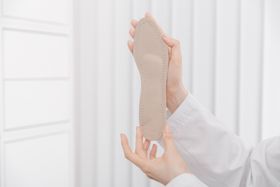Can Memory Foam Insoles Cause Plantar Fasciitis?
Memory foam insoles seem comfortable at first, but they could potentially be causing more problems than they are solving. Read this article to find out more.
Updated March 31, 2023
Memory foam insoles seem like a great idea when you first purchase them as there are few materials that could match them in comfort. Especially if you suffer from some form of foot or heel pain, the extra cushioning could provide some relief that you might believe is exactly what you need.
Unfortunately, memory foam insoles could potentially cause more problems than they solve.
Pros and Cons of Memory Foam Insoles
Memory Foam is Plastic and Elastic
Memory foam molds to whatever shape exerts pressure on it, and while this could be supportive in an individual with perfect form and foot design, memory foam will naturally mold to a poor gait as well. If you have slight issues with your feet, the memory foam will adhere to those errors and exacerbate them as the insoles start to degrade over time.
Memory Foam Doesn’t Last Long
Whereas hard-plastic insoles can last a few years without needing to be replaced, memory foam tends to degrade rapidly and so any issues that are caused by memory foam insoles can quickly become severe.
Memory Foam May Cause Long-Term Issues
Even if you don't have severe issues in your feet, the problems caused by memory foam insoles are not immediately noticeable and therefore not immediately attributed to the insoles. If your feet are slightly destabilized, it could lead to minor issues throughout your legs, hips, and lower back, that become more prominent over time and lead to secondary conditions such as overpronation and plantar fasciitis. You may not even notice some developed issues being directly caused by your memory foam insoles as they wouldn't necessarily feel uncomfortable compared to harder insoles.
Should You Wear Memory Foam Insoles?
Unless you can verify that your gait and foot position is 100% perfect, memory foam insoles seem to present more risk than reward. If you do have foot issues that need addressing with the use of insoles, consult a podiatrist as they can recommend the correct type of insole for your specific criteria.
» Learn more about different kinds of custom orthotics for plantar fasciitis by reading our guide on memory foam vs. gel insoles
Related Articles

Why and When Should You Use Custom Orthotics?
Joel Taylor
September 18, 2024

Orthotics for Bunions: How Insoles Can Relieve Bunion Pain
Babafemi Adebajo
February 28, 2022

Ankle Pain When Walking: Most Common Causes
Janik Sundstrom
December 9, 2024

What Is a Stone Bruise and What Can You Do About It?
Upstep Staff
October 16, 2025

Best Insoles For Hip Pain Relief
Janik Sundstrom
September 23, 2025
Related Posts
Babafemi Adebajo
7 Best Cycling Shoe Insoles for Plantar Fasciitis
Babafemi Adebajo
Things to Avoid With Plantar Fasciitis
Dr. Pooja Gajare



